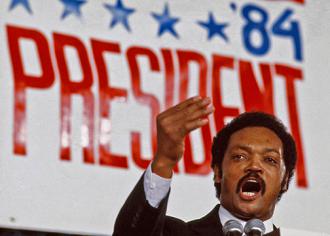By: Trevor Loudon | New Zeal
Part 4 here.
This unholy alliance is working on a new Rainbow Coalition. This time its called the “New American Majority” – and its coming to a polling place near you.
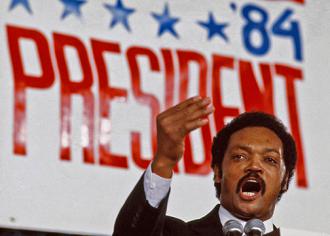
Jesse Jackson for President 1984
Former Stanford University Marxist-Leninist student radical Steve Phillips is now a San Francisco lawyer and a Democratic Party power broker. Married into the billionaire Sandler family, Steve Phillips is using his wealth and influence to move the Democratic Party and the country permanently to the far left. He is funding stealth leftist candidates of color across the country and directing huge resources into voter registration drives among Black, Latino and Asian American communities to create an unbeatable “New American Majority.”
In his book, Brown is the New White, Phillips makes it very clear that there is an unbroken line between Jesse Jackson’s Rainbow Coalition of the 1980s, the Obama movement of 2008 and the emerging “New American Majority.”
Steve Phillips should know, he was involved every step of the way.
I was a delegate to Jackson’s 1984 and 1988 campaigns, and I took a year off from college to serve as the California student coordinator of his 1988 campaign. Through that baptism by political campaign, I learned some lasting truths about politics and social change. Before Barack Obama went to law school, before Spike Lee made his first movie, before Shonda Rhimes could even dream of writing television shows featuring actors of color, a forty-two-year-old Black civil rights leader shook up the political system by running for president of the United States of America. To get from Martin in 1968 to Barack in 2008, we needed Jesse in 1984 and 1988.
It was during the presidential elections of the 1980s that the seeds planted in the 1960s began to sprout and become visible in national politics. Jackson was fond of saying, “When the old minorities come together, they form a new majority.” The potential of this prophecy came into sharp focus in the 1988 campaign as Jackson won the presidential primaries in eleven states, led the race for the Democratic nomination near the halfway point, and finished as the Democratic runner-up with the most votes in history up to that time. The key to Jackson’s success—and Obama’s electoral victories twenty years later—was the power of connecting the energy of people of color and progressive Whites seeking justice, equality, and social change to a political campaign for elected office…
As a result of these types of efforts, millions of people of color and progressive Whites were inspired to register to vote and turn out at the polls in 1984. Two years later, large and enthusiastic voting by people of color helped Democrats win closely contested U.S. Senate races in the heavily Black and Latino Southern and Southwestern states of Georgia, Alabama, Florida, Maryland, Nevada, and North Carolina, capturing control of the Senate from the Republicans. Because the embryonic New American Majority had begun to flex its power in this fashion…
So, if Jesse Jackson’s Rainbow Coalition is the model for Steve Phillips’s “New American Majority,” maybe it might be be worth traveling back to the eighties?
The National Rainbow Coalition grew out of Jesse Jackson’s 1984 presidential campaign. During the campaign, Jackson began speaking about a “Rainbow Coalition,” an idea popularized by the late Chicago Black Panther Party leader Fred Hampton.
At the 1984 Democratic National Convention on July 18, 1984, in San Francisco, California, Jackson laid out his plans with a speech entitled: “The Rainbow Coalition.”
According to Walter Shapiro:
The speech called for Arab Americans, Native Americans, Asian Americans, youth, disabled veterans, small farmers, lesbians and gays to join with African Americans and Jewish Americans for political purpose. Whereas the purpose of PUSH had been to fight for economic and educational opportunities, the Rainbow Coalition was created to address political empowerment and public policy issues. After his unsuccessful bid for the Democratic nomination in 1984, Jackson attempted to build a broad base of support among groups that “were hurt by Reagan administration policies” – racial minorities, the poor, small farmers, working mothers, the unemployed, some labor union members, gays, and lesbians.
After hobnobbing with foreign communists such as Soviet leader Mikhail Gorbachev, Cuban leader Fiden Castro and Palestinian terrorist leader Yasser Arafat, Jesse Jackson had no problem welcoming American Marxists into his movement.
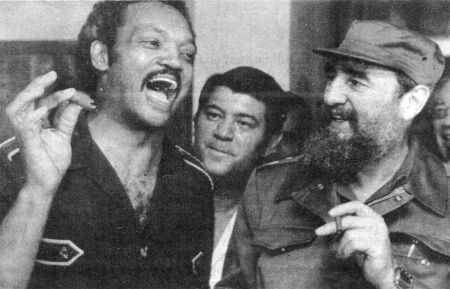
Jesse Jackson, Fidel Castro, Cuba 1984
According to activists Tre Kwon and Jemena Vergara:
At the time of Ronald Reagan’s 1980 election, the political situation was moving rapidly to the right. The Democratic Party was in retreat, trying to find the way to recover from the blows. In 1984, the left wing of the Democratic Party and its satellite organizations attempted to win the primaries through the Rainbow Coalition, headed by known Civil Rights Movement figure, Jesse Jackson. The goals of the campaign were to oppose Reaganomics and gain support from Blacks, working-class people, immigrants, women, and the LGBT community.
A significant portion of the left found it necessary to back Jackson’s campaign, or risk missing out on an important political opportunity. Organizations like the League of Revolutionary Struggle (M-L), Communist Party USA (CPUSA), Line of March (LOM), the Communist Workers Party (CWP) and the Democratic Socialists of America endorsed Jackson’s candidacy.
The hard left didn’t just endorse the Rainbow, they ran it. It’s no exaggeration to say that the Rainbow Coalition was a “communist front.”
The Communist Party USA’s Daily World said on April 13, 1984, during the Presidential primaries:
The answer to Reagan and Bush is to redouble efforts to build and strengthen the all peoples’ front, a vital part of which is the campaign being waged on the issues by Jesse Jackson.
Communist Party vice presidential candidate Angela Davis chimed in:
The Jesse Jackson campaign is going to force the Democratic Party to speak on issues that they ordinarily would not address.
Leader Gus Hall, when asked who the Communist Party would support for President in the 1988 election, said:
As a political party we do not endorse candidates of other political parties. Communists as individuals work in the election campaign, even in the campaigns of other candidates, not only Communist candidates. I think our members will work for the candidates they think have the most progressive, most advanced positions. At this stage most members of the Party will be working for Jesse Jackson on the basis that he does have an advanced position. But we do not endorse any candidate, including Jackson.
A principal adviser to Jackson for more than 20 years was Communist Party USA veteran Jack O’Dell. O’Dell was International Affairs Director for Jackson’s Operation PUSH in Chicago from the early 1960s onwards and later for Jackson’s Rainbow Coalition, where he served into the late 1980s.
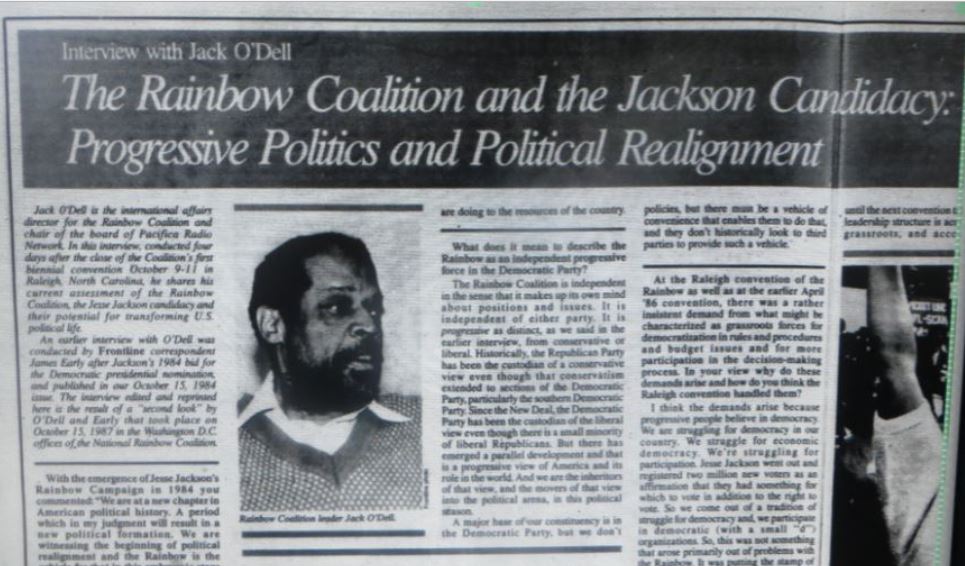
Frontline, November 9, 1987
Actor Ossie Davis, a longtime Communist Party supporter, served on the Rainbow Coalition’s National Board in 1987, as did “former” Party members lawyer Arthur Kinoy, Kentucky civil rights activist Anne Braden and Party supporter Rev. Ben Chavis. Longtime Communist Party supporter (now Congresswoman) Maxine Waters also served, as did Manhattan Borough President and Party supporter Percy Sutton, reportedly a “money man” during Jackson’s 1984 run for the Presidency.
Coleman Young, Mayor of Detroit and a longtime Communist Party member, was also a Rainbow supporter. Harry Hay, a “former’ communist and founder of the gay rights movement, was a local founder of the Lavender Caucus of Jesse Jackson’s Rainbow Coalition during the early 1980s. Hay was “determined to help convince the gay community that its political success was inextricably tied to a broader progressive agenda.”
The Party was also active on the ground. For instance, longtime Iowa communist Ray Teeple was a leader of the state Rainbow Coalition, while Party supporter Tom Mohan was Iowa State Rainbow director.
Democratic Socialists of America largely missed the boat in 1984, but were all in by 1988.
Longtime Democratic Socialists of America supporter Heather Booth served on the 1987 Rainbow Board, as did DSA comrades Dolores Huerta of the United Farmworkers, Gray Panthers founder Maggie Kuhn, Hilda Hason of the Washington DC City Council and William Winpisinger, President of the International Association of Machinists and Aerospace Workers.
DSA supporter Jan Pierce co-chaied the Rainbow’s Labor Commission. Shakoor Aljuwani became the DSA staff person working to build support for the Rainbow Coalition, focusing on building Labor for Jackson committees. In 1988, AFSCME leader and DSA comrade Stanley Hill was co-chair of the Jesse Jackson campaign in New York. DSAer Tim Carpenter was a “trusted aide” to the Rev. Jackson’s 1988 campaign, while comrade Rhys Scholes helped run things on the ground in Oregon. In Hawaii, DSA couple Nancie Caraway and future state Governor Neil Abercrombie were both prominent in the Rainbow Coalition.
Ben Nichols, Mayor of Ithaca New York, David Dinkins, Mayor of new York City, and Jim Scheibel, Mayor of St. Paul Minnesota, were all DSA comrades who owed their positions to the Rainbow Coalition.
Kurt Stand, a DSA comrade in Washington, DC helped the Spring 1988 issue of the Rainbow Organizer. At the time he led a spy ring, stealing military secrets for communist East Germany. He was later sentenced to 17 years in prison.
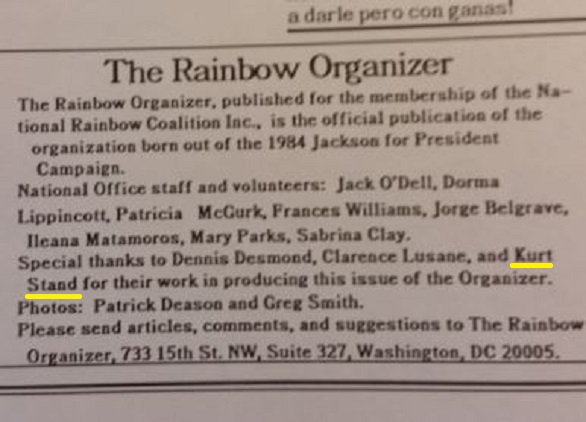
Rainbow Organizer Spring 1988
It was the Maoists however, who really ran the Rainbow organization.
The Communist Workers Party chased the Rainbow early on. Supporters of China and North Korea, the ultra-violent CWP originally disdained electoral politics, but changed tactics just in time to get behind Jesse Jackson’s 1984 bid. They mainly worked through their still existing New York front group Asian Americans for Equality.
In 1984, Asian Americans for Equality activist Bill Chong was National vice-chair of Asians for the Jackson Campaign. His comrade Linda Peng was New York State Asian American Jackson campaign coordinator. Regular contributor to the CWP’s Workers Viewpoint newspaper Mike Alexander became Mississippi state coordinator for the 1988 Jackson campaign.
In 1984, Communist Workers Party leader Phil Thompson toured the country rousing support for Jesse Jackson.

Phil Thompson Jackson tour
At a convention in mid-1985, the CWP formally dissolved itself, in its place arose a new organization, the New Democratic Movement, devoted to establishing “local power bases” inside the Democratic Party. There was nothing “democratic” about the new group. Jerry Tung, general secretary of the former CWP, explained his strategy to the faithful. “[O]nce you get people elected or appointed to office, you can award contracts to friends…. When you can raise money for political purposes, when you do it in the right place in the right atmosphere, and look right, and the [mainstream] party bosses are there, then that money makes them take you seriously.”
Former CWP members are still very powerful in the New York Democratic Party and also around Southern California Congresswoman Judy Chu.
Next in line to board the Jackson train was Line of March. Originally Maoist, by 1990, LOM was strongly supportive of Soviet leader Mikhail Gorbachev.
Line of March held multiple key positions in the Rainbow. LOM activists in the Rainbow included Carla Wallace, steering committee Kentucky Rainbow Coalition and Clarence Lusane, a leading Washington, DC activist. In 1984, LOM supporter Josie Camacho was Rainbow Coalition co-chair in California’s 8th District; in 1989, Larry Hobson was co-chair of the USC-Fresno Rainbow Coalition; and Leni Marin was chairman of Filipinos for Jackson.
In 1984, Lillian Galedo was a leader of Filipinos in the Rainbow Coalition. In 1988, Pam David was co-chair of Lesbians and Gays for Jackson, Romy Garcia was a member of the interim steering committee of the Washington Rainbow Coalition and Vicki Alexander was the co-chair of Rainbow Coalition Women’s Commission and a Rainbow National Board member.
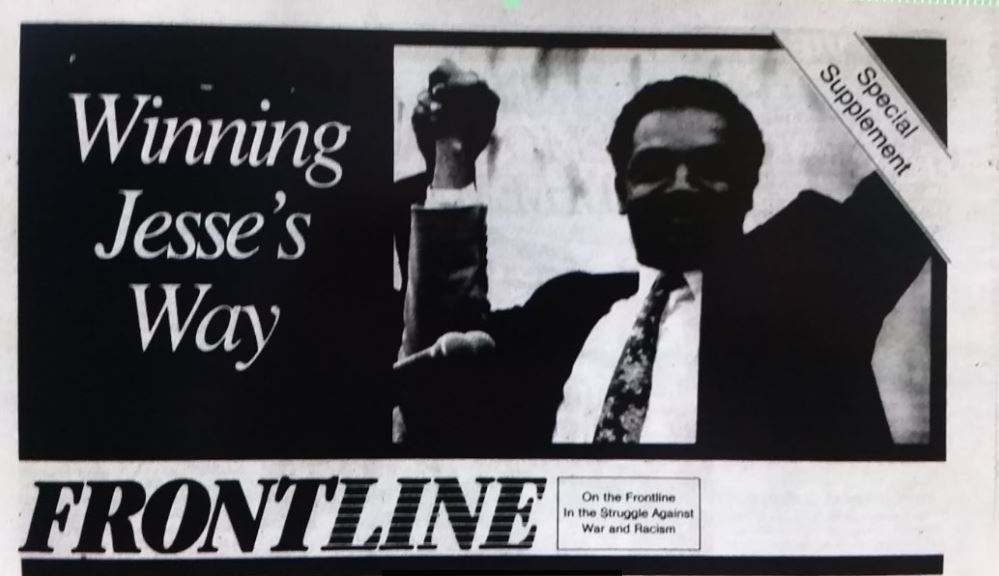
Line of March’s Frontline, April 11 1988
Line of March was probably the second most powerful faction inside the Rainbow. The number one spot went hands down to Steve Phillips’ comrades in the League of Revolutionary Struggle.
The LRS was behind Jackson right from the beginning. League leader Amiri Baraka was urging Jackson to run for President in the pages of Unity as early as January 1984.
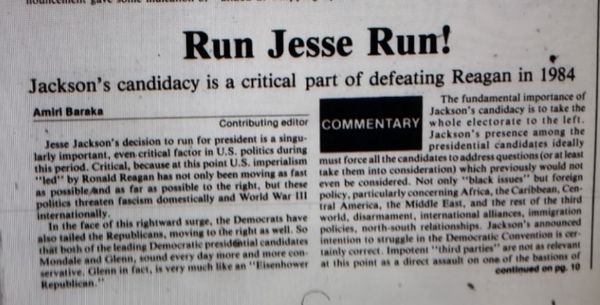
Unity January 25 1984
The League and its supporters dominated the Rainbow in California, Boston and to a slightly lesser degree in New York and Chicago. Altogether the League probably had at least a thousand members working inside the Rainbow.
Notable LRS/Rainbow members include Mike Murase and Butch Wing, who both served on the National Rainbow Board and were trusted Jackson advisers. LRS supporters Sasha Hohri (New York Asians for Jesse Jackson) and Nebraska farm activist Merle Hansen, who doubled as Jackson’s agricultural adviser, also served on the National Board. LRS comrade Eddie Wong was national field director for the 1988 Jesse Jackson for President campaign.
Further down the food chain, LRS supporter Tracy Takano served as chair of the Hawaii Rainbow Coalition, while comrades Mae Louie chaired the Boston Rainbow and Cliff Joseph led Artists for Jackson in New York. The LRS permeated Jackson’s organization in both 1984 and 1988. Today many of them are involved in the new Rainbow Coalition – currently in production.
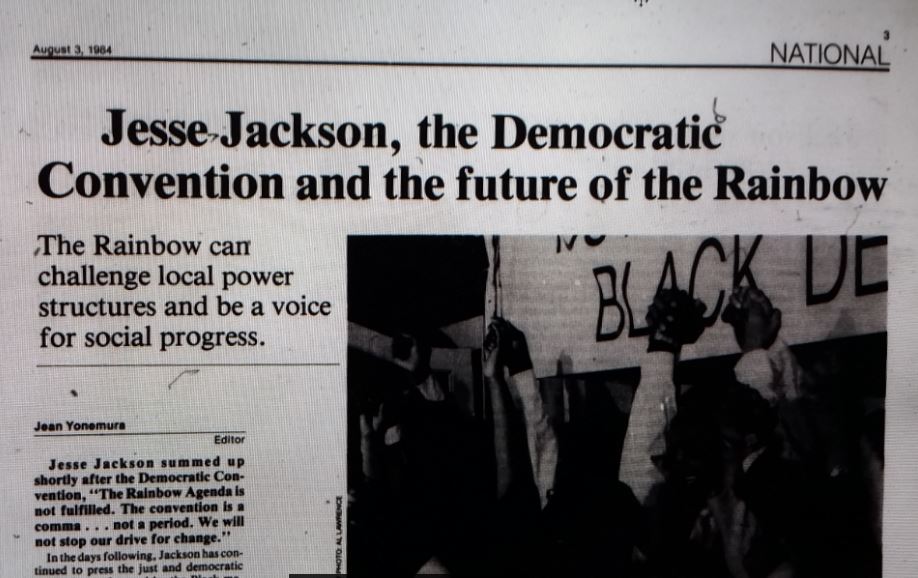
Unity August 3, 1984
One more Rainbow sub-group deserves mention, the Freedom Road Socialist Organization. Strong in the Midwest, Boston and New York, Freedom Road (or its ancestor groups) dedicated many of their cadre and supporters to both Jackson campaigns.
FRSO comrade Bill Fletcher was the Boston labor coordinator for the Jackson campaign. Comrades Patrick McCann and Mike Meiselman were Rainbow leaders in Maryland, Jon Liss manned the barricades in Northern Virginia, while Kris Penniston was active in the Madison Wisconsin Coalition. Boston FRSO supporter Gene Bruskin served as the labor director for the Rainbow Coalition.
According to Freedom Road:
Jackson had the most left platform of any major party candidate in the 20th century. He won support from a “broad array of forces—African Americans, naturally, and other oppressed nationality communities, but also several unions, white family farmers in the Midwest crippled by the Reagan Recession, gays facing the first great wave of AIDS deaths, feminists, students and more. Much of the organized socialist left in the US, and an even larger section of unaffiliated reds and revolutionaries threw themselves into the campaigns”.
Jackson’s newly formed National Rainbow Coalition, billed as an independent form that would fight inside and outside of the Democratic Party for a radical agenda, provided a common project for comrades to work on and around. Now we could test and strengthen the unity we had built. In 1988, Jackson won nearly a third of the delegates, and the “Democratic Party moved hard to co-opt him”.
When Jackson slid into the Democratic Party mainstream he tried to bring his whole campaign with him. But FRSO members joined others fighting to keep their state Rainbows independent until he dissolved them.
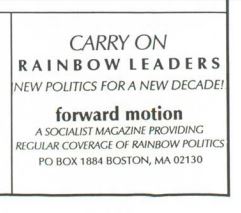
Freedom Road’s Forward Motion magazine circa 1988
Jesse Jackson’s Rainbow Coalition earned a respectable 7 million votes in 1988. Most of his cadre were fired up to run again in 1992, but Jesse Jackson seemed more interested in moving “mainstream.” In 1990-91, the Communist Party split, as did the League of Revolutionary Struggle. The Line of March imploded in tandem with its beloved Soviet Union. The Rainbow’s base was severely weakened. There simply wasn’t the infrastructure to maintain the Rainbow and it soon collapsed.
The League of Revolutionary Struggle split two ways. The majority faction became the Unity Organizing Committee, remnants of which form the backbone of Steve Phillips’ PowerPAC+.
The smaller Socialist Organizing Network eventually folded into the Freedom Road Socialist Organization, which also absorbed some remnants of the Communist Workers Party and Line of March, to become a major player in today’s American left.
In 2017, Freedom Road entered into an alliance with the Communist Party USA and Democratic Socialists of America to rebuild the Rainbow inside and outside of the Democratic Party. Freedom Road is also close to Steve Phillips and PowerPAC+
This unholy alliance is working on a new Rainbow Coalition. This time its called the “New American Majority” – and its coming to a polling place near you.
Look for Part 6 coming soon: “From Jesse Jackson’s Rainbow Coalition to Steve Phillips’ ‘New American Majority'”
A book entitled “The Rainbow Conspiracy” will be released in October 2018.

